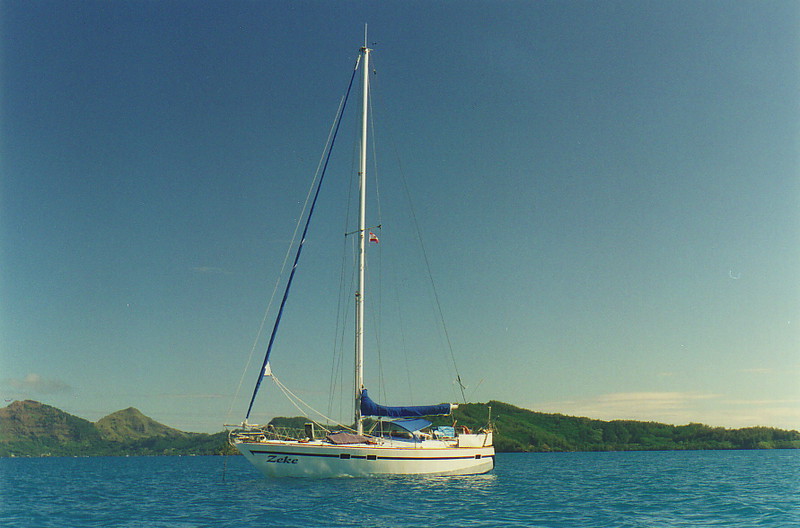
Quick! Let me grab the moment and describe the feeling, as it's a succinct summary of the sub-tropical paradise of anchoring off Île Mangareva. The date – I have to check this electronically as I have absolutely no idea what day of the week it is, let alone what date – is Monday 26th May, and it's 9.30pm, after dark.
Zeke is moored in the beautifully sheltered harbour at Rikitea, the water gently rippling against the sides and lapping the dinghy with slightly metallic slaps, a homely sound because it shows we haven't lost our means of getting to shore. The last three days have been pretty miserable (in terms of weather, not lifestyle), and this is the calm after the storm.
That's why the air feels so clean, so light, so cooling. The humidity that can build up in the sub-tropics is totally absent, and the gentle breeze wafts the smoky scent of the locals' fires over the bow, where I'm sitting. Rikitea is spread around me like an arc, a crescent row of electric bulbs running from the town generator, reflecting in the water like lantern light reflecting off the river at Mardi Gras, like restaurant table light glimmering off the Seine as cognac and cigars are served, like pub firelight shining over the canal boats tied up alongside... it's a painting, and the air is still.

But not totally still. Surrounding Zeke are the other boats that have been sheltering in Rikitea for the last few days: Tegan, where Joe and Janet are sitting outside, listening to music on their wonderful waterproof hi-fi, a cigar glowing in the dark and the occasional lilt of Canadian accent floating over the water (ironically the song's 'Another Day' by Paul McCartney, a song all about the repetitiveness of working life); Teba, the huge French boat that we befriended in Whangarei and kept in contact with all the way over, where there is activity involving generators and flickering torchlight; the schooner1 Jan van Gent, whose crew are the very friendly Canadians Richard and Gail; these boats and others are all here, creating a community feel in an otherwise empty arc of water.
When yachts get together, they synchronise. This isn't a social phenomenon: it's physical. When a number of yachts are anchored in the same spot, they do the maritime equivalent of synchronised swimming; when the wind blows, yachts turn bow into the wind because of the way they're shaped, and to the casual observer it looks as if the yachts are obeying some cosmic law of conformity, all swinging in the same way like a ballroom dancing troupe. It's yet another way the community feeling gets strengthened in the harbour, albeit subliminally.
This is the feeling, then, of the real sub-tropics. Here there are no work pressures, no western stresses, no traffic jams, no worries about where to get food, no pollution (beyond the French nuclear legacy and the dodgy fish) and no similarity to city life that I can see. Now I've been here for a little while, it's become second nature to relax, procrastinate and live for the moment, with a healthy regard for doing those little jobs on the boat that still need to be done. It's a pleasant feeling, one made more enjoyable by the fact that after the first few days, when the sheer joy of reaching land had worn off, life became surprisingly mundane.
It's a weird concept, being morose in paradise, but it's understandable. Both Rob and I found that having survived the voyage from hell, and having Laurent jump ship, life suddenly took a turn, a change from constant stress, both physical and mental, to an existence where all-night sleeping sessions were a reality, there were no watches to keep, the boat didn't roll and the food was fresh. The thrill of this was great for a few days – I would say incredible, in all fairness – but it hits everyone sooner or later: paradise complacency. It only lasts for a couple of days, but the feeling of being strangely unimpressed and, I dare say, a little depressed in the midst of heaven is interesting, to say the least. It's understandable as the psychological calm after the storm, but it's still a strange phenomenon. Needless to say, we got over it pretty quickly.
That's just one more reason why the gentle serenity of this nocturnal harbour scene is so beautiful. We've not only arrived, we've begun to adjust, and now the cruising really starts. Roll on the Pacific Islands...
Tonight truly is the calm after the storm.
1 A quick course in yacht types might be handy. The most common is the sloop, of which Zeke is an example: a sloop has one main mast, with one sail on a boom behind it and one sail in front (the mainsail and jib, as previously explained). If there's one mast and two sails in front of the mast, it's a cutter, like Teba. A schooner like Jan van Gent has two masts, with the front mast being smaller than the back. A ketch has two masts, but the other way round to a schooner – the front mast is taller than the back – and a yawl is a ketch whose rear boom hangs over the back of the boat (normally the boom is totally inside the lines of the boat). So now you've got enough info to hop on down to Great Yarmouth and sound knowledgeable... and interestingly, at one point in our visit there was at least one of each of these types present at Rikitea, something of a rare occurrence in such a remote spot as the Gambiers.